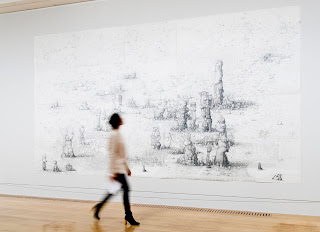This article was published in the autumn Kensington & Chelsea Review: http://www.kensingtonandchelseareview.com/
This year’s Turner Prize exhibition, showing at the Tate Britain with the prize awarded in December, is notable for the variety but consistently high quality of all four nominees. There is little dryness or alienating critical distance in this immersive, captivating and highly enjoyable show. At its worst it draws the audience into the artists’ unique manias in a way that can feel slightly stifling; at its best – exemplified in particular by performance artist Spartacus Chetwynd – it showcases a fresh, multi-disciplinary approach that is both playful and thoughtful.
This year’s Turner Prize exhibition, showing at the Tate Britain with the prize awarded in December, is notable for the variety but consistently high quality of all four nominees. There is little dryness or alienating critical distance in this immersive, captivating and highly enjoyable show. At its worst it draws the audience into the artists’ unique manias in a way that can feel slightly stifling; at its best – exemplified in particular by performance artist Spartacus Chetwynd – it showcases a fresh, multi-disciplinary approach that is both playful and thoughtful.
(Paul Noble. From the Tate's press pack)
Two names have dominated the discussion of
the Turner Prize so far: Chetwynd, whose vibrant group performances present a
rich mix of social and aesthetic concepts through a mad, often hilarious and
sometimes very spooky theatricality, and Paul Noble, whose pencil drawings
document an imaginary world in painstaking Escher-like architectural detail.
Noble’s work is clearly impressive in terms of skill and commitment, though a
painstaking work ethic is a defining feature of this years’ nominees. Several
critics have pointed out the resemblance to excrement in his drawings, and
although it is undeniable it’s rarely overwhelming. There’s an addictive beauty
to his intricate patterns: they feel like illustrations in an impossible book.
But in fact he is the least satisfying – and the least interesting - of the
four artists. I want to get lost in his world, but I can’t: it is too mapped
out, too limited by his artistic monomania. In the words of Bruno Schulz, there
is ‘too much matter, not enough form.’
(Elizabeth Price. From the Tate's press pack)
Elizabeth Price has a lot more to say, and
more to say it with. Her film ostensibly tells the story of deadly fire in a
Manchester Woolworth’s. The disturbing subject matter is matched by a
purposefully overpowering, high tempo approach to filmmaking that darts from
source to source and image to image, melding contrasting narratives and ideas
into a cohesive piece. But the quick, controlled pace and the merging of text
and image are a little too reminiscent of advertising, making the work feel
slightly hollow.
(Luke Fowler. From the Tate's press pack)
Luke Fowler presents a refreshing contrast
to this. His film All Divided Selves documents
the life, work and opinions of controversial psychiatrist R D Laing through a
montage of archive film, found footage and new material. Unlike Noble, he’s
firmly rooted in the real world, addressing Laing’s radical notion of
schizophrenia as rational. His form perfectly reflects his subject matter:
virtuosic editing weaves different strands of footage together, finding both
beauty and thematic logic within non-linear expression – exactly the same way
that Laing’s work treated expressions of schizophrenia. Implicit throughout the
film is the idea that schizophrenic thought closely resembles artistic thought
in its merging of imagination and experience. Through documentation, Fowler
shows that Laing saw art in madness; through his own artistic process, Fowler
presents the madness in art.
(Spartacus Chetwynd. From the Tate's press pack)
But he’s certainly dwarfed by Spartacus
Chetwynd in that field. Her work embraces madness and irrationality on a level
beyond most mainstream contemporary art. Chetwynd is the first performance
artist ever to be nominated for the Turner Prize – highlighting the fact that,
despite its outrageous reputation among tabloid rants, the prize is often
relatively conservative. Although all the nominees are impressive, it’s
Chetwynd who gives the exhibition its exciting, refreshing and immersive
quality. Her performance piece Odd Man Out has
two sides. In one room, masked puppeteers perform the Biblical story of
Barabbas being spared crucifixion. In another, awkwardly acrobatic monsters
bring a mandrake root to life which dishes out banal and gently negative
oracular predictions about (among other things) oyster cards and gas bills.
Everything looks amazing, from the photocopied images that coat the space to
the ragged robes of the performers. There’s a lot to take away from the
performance rather than a single prescribed meaning, which makes it frustrating
to write about but glorious to see: if I talk about the telling parallel
between the disappointing oracle and the crowd choosing the criminal Barabbas
over the prophet, I have to reconcile this with the piece’s exuberance, it’s
sexuality and raw energy; if I talk about the slick, Brechtian theatricality of
the work, I’m in danger of forgetting the feeling I had while watching that
this could fall apart at any minute and that I, as an audience member, was just
as responsible for holding it together as the performers were. This is a
challenging piece, joyful and manic but without a trace of naivety or tweeness.
Perhaps it would be simplest to say there is an excess of meaning here, and
that that in itself is its strength: a reminder that reality is not restricted
to linear or singular notions of meaning and truth, but is rather a shifting,
complicated and beautiful mess – just like Chetwynd’s work. And, despite the
consistently high quality of the work on display this year, it is that feeling
that makes the 2012 Turner Prize exciting, relevant and unique.




No comments:
Post a Comment